 Narrowsburg
NarrowsburgLight Rain Fog/Mist, 43°
Wind: 8.1 mph
 Narrowsburg
Narrowsburg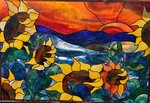

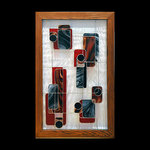
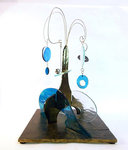
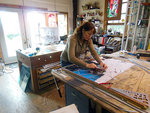
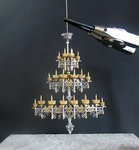
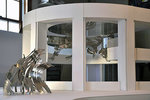
Somewhere below the Neversink Reservoir live and work stained-glass artisan Joan Nicole Schlafer and her design partner, Nicholas Clemente. Together they share a spacious six-acre property with multi-faceted art studios. However, before settling here, these two mega-talents looked far and wide for just the right inspiring space.
“In 2002 Nick and I were looking to purchase a home to build and expand our life together that would provide us with space enough for our various art studios, including jewelry and stained glass fabrication; scale-model making for theater, television and film; traditional painting and drawing; graphic design; music and sound recording,” says Schlafer. “We also wanted land and to be surrounded by natural beauty. Neither of us was very familiar with Sullivan County; a friend suggested we look at some homes in the area.”
Prior to homesteading in Sullivan County, the two were sharing a studio space in Sugar Loaf, NY. Initially, they looked in Orange, Ulster and Delaware counties, but branched out to Sullivan County when they couldn’t find the right place. “We instantly fell in love with the mountain views here,” Scdhlafer said, “and the property certainly had enough space for our various studios. We took a leap of faith.”
Schafler and Clemente moved their collective studios along with their brood of pet cats—El Pud, Oli and Kali—and founded Light Curves Glass where they finally consolidated their talents.
“We instantly began supporting each other’s work,” says Schafler. “Nick is my sounding board and design partner. We have worked on pieces together, sometimes sketching at the same time or going back and forth. Our first real hands-on collaboration was when I was working on a porcelain sculpture for fun. I was stuck, and so Nick asked if he could do something to it and I said ‘sure.’ He took a knife and split it in half and shifted it two inches apart. It looked much better, so we continued working on the piece together. And what started out as a realistic nude became an abstract cubist piece.
“It is natural for me to be collaborative, coming from a set-design background and collaborating with a team of designers. It is amazing how two minds can push each other to explore new directions. It makes the creative experience more unpredictable.”
In 2015, the pair had their first art show together at the Stray Cat Gallery in Bethel, NY. The experience of working together inspired Schlafer to take Clemente’s painting, “Sun Serpent Road,” and recreate it in glass. “It was perfect for mosaic, so I created my first mosaic glass on glass work,” says Schlafer.
Schafler designs traditional stained glass using a “lead came putty” and a Tiffany-styled copper-foil method along with “glass fusing and slumping. I was lucky to travel to Siena, Italy and study under ecclesiastical artist Alberto Postiano, who comes from a line of Italian glass artisans,” says Schlafer. “His mentor was FiozenzoIoni. I feel very privileged to have learned from such a master glass artist.”
Schafler also learned the art of glass painting known as “silver stain;” hence the term “stained glass,” in which paint actually stains the glass. She uses traditional grisaille, a powder-glass paint that is applied with brushes and various mediums depending on the desired look. “I learned a method of airbrushing in layers and removing paint to reveal the light, rather than painting the shadows. It’s a technique that Alberto developed,” adds Schafler.
“As an artist, the most humbling reality is that whatever we create is never as beautiful as Mother Nature’s art. I am constantly trying to capture just a glimmer of her perfection. I love the sheer beauty of the glass, pure rich color... For me, color is a drug that can instantly lift my mood.”
According to Schlafer, working in glass originally came as a complete surprise.“My education was in fashion design with a degree from Parsons. At first, I wanted to be a fine artist or sculptor; but knowing that it was not a lucrative field, I opted to study illustration, then transferred into fashion design.”
Upon graduation and the realization that fashion was not, after all, her direction, Schlafer mailed a letter and resume to film and Broadway set/costume designer Tony Walton. As luck would have it, a stage door attendant at the Martin Beck Theater personally handed her letter to Walton, who immediately hired her for the off-Broadway production of “Square One.” The job required both sewing and pattern-making skills. Schlafer created five oversized stuffed animals that stood up to seven feet tall. She worked with Walton for the next 17 years until one day when...
“I fell into the art of stained glass when I took a friend to a glass shop in Patterson, NJ,” Shlafer recalls.“There I found myself picking up sheets of glass. It was all just so beautiful. The colors popped out at me. The movement and the surprise colors that emerged when I held it up to the light were intoxicating. I ended up spending a few hundred dollars on glass, not knowing anything about how to do it.”
Though she was still involved in the world of set design, Schlafer always thought that one day she’d have a glass studio. Walton was very supportive and actually purchased one of Schlafer’s first windows for $3,000. The money allowed her to buy more glass and set up a viable business. Inspired, she expanded her studies both at Manhattan’s Bendheim Glass and the Vertrate Artiste Tuscane Glass Studio in Italy.
“I have been working in glass since 1990, and my technique is still evolving,” adds Schlafer. “I am grateful that I challenged myself to push the limits of the glass. There is always something new to learn.”
To learn more about Light Curves Glass, visit www.lightcurves.etsy.com or call 845/978-7653.
The process of creating a stained glass window
Designing:
At Light Curves Glass, before building any piece a drawing is created. Schlafer and Clemente often work together on refining any and all designs. Once a design is decided upon, a pattern is created. “This part is tricky because you need to think about the glass shapes and decide where to put the lines to enhance the drawing. You also have to keep in mind that you have to cut the shape in glass so choosing the glass is important,” explains Schlafer. Once the glass is chosen, Clemente creates a very true computerized rendition of the completed window so the client can better visualize the finished piece.
Cutting and Assembling:
Next is “grousing” and cutting the glass with a glass cutter, pliers and/or a diamond wet saw. Copper foil is then applied to the edges and burnished on when using the Tiffany method. If the piece is leaded it is put together and slipped into channels and then soldered using Schafler’s own old-school putty mix of whiting, raw and/or boiled linseed oils. No matter the mode, “Each window is put together like a puzzle working from one corner out until the piece is completed,” says Schlafer.
Curing:
For certain works, the curing time can take weeks, depending on method, humidity and temperature. With leading, for example, the piece is brushed every couple of days and more whiting and oil are applied. This period of drying is crucial in obtaining a proper finish. Each piece is then cleaned and finished by buffing to polish or applying patinas.
Comments
No comments on this item Please log in to comment by clicking here